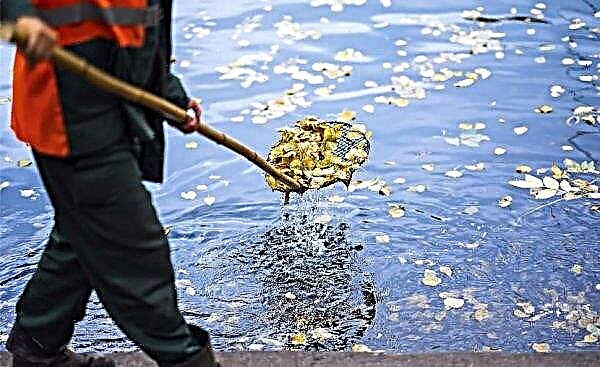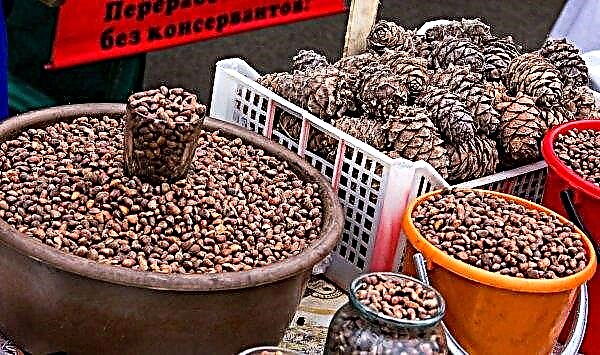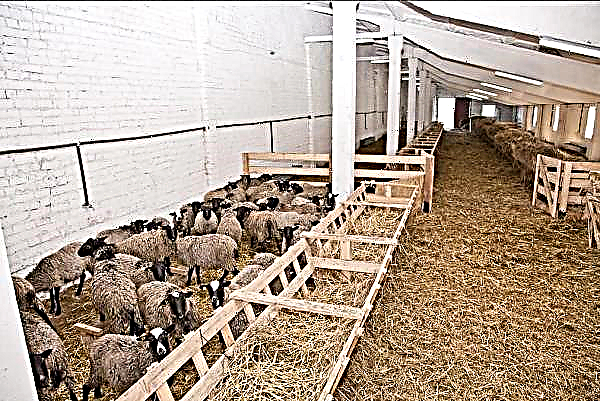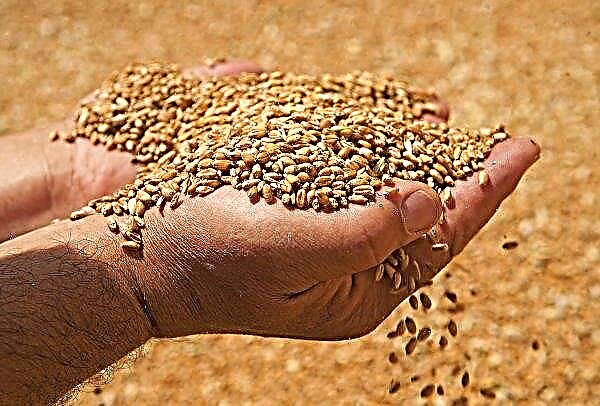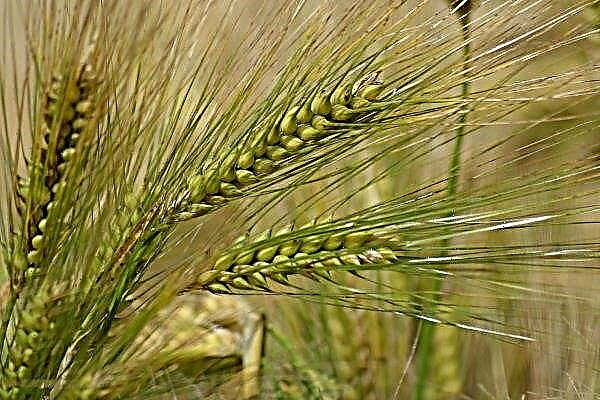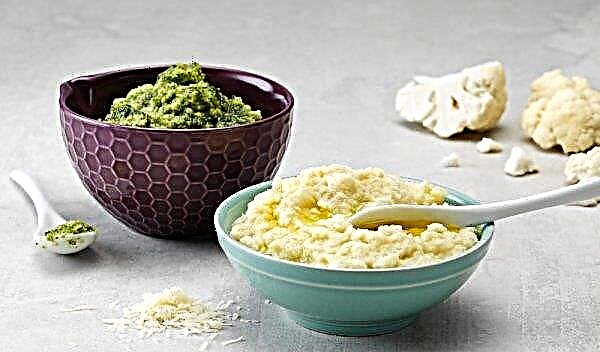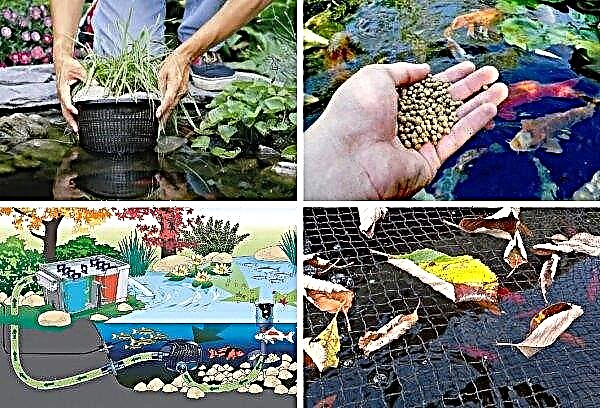A fairly common problem for beginner poultry farmers is the choice of an incubator that would suit not only with its technical characteristics, but also with its cost. One such option is the Kvochka incubator. How to use it correctly, you can learn from this article.
Kvochka incubator: device description
- The advantages of this type of incubator include:
- ease of use;
- low price;
- small dimensions and weight;
- lack of malfunctions;
- the presence of a thermometer (liquid in the early models and digital in the latest model), which allows you to accurately measure the temperature;
- acceptable quality.
- The disadvantages of the product include:
- manual turning of eggs or manual rotation of the apparatus for their revolution (in the latest model);
- fragile body;
- noise from the fan.
Did you know? Maleo chickens living on Sulawesi Island (Indonesia) do not hatch offspring — they make incubators in the sand for their eggs.
Specifications
Technical parameters of the device are determined by such indicators:
- Together with the packaging, the mass is 2.3–2.5 kg.
- External product size: length 47 cm, width 47 cm, height 21 cm.
- For normal operation, a network voltage of 220 V is required, the frequency is 50 Hz.
- For 1 month of operation, it consumes no more than 10 kW / h of energy.

Production characteristics
The performance of the device is determined by such parameters:
- The number of quail eggs - 180-200 pcs.
- The number of eggs is up to 80 pcs.
- The number of goose eggs - 40-50 pcs.
- The number of duck or turkey eggs is 50–70 pcs.
Types of Kvochka incubators
The following types of Kvochka incubators are on sale:
- MI-30 - The easiest and cheapest option. A lamp-type heater is installed, consisting of 4 lamps and a reflector. The temperature in the device does not require adjustment, it is set at + 37.8 ... + 38.3 ° C. Eggs must be turned manually. It is required to monitor humidity and add water.

- MI-30-1 - A modified version, characterized by the presence of a digital thermometer inside the device.

- MI-30-1-E - Modern advanced design, equipped instead of lamps TEN. It has not only a digital thermometer, but also a digital temperature controller. The method of turning the eggs is mechanical, periodically it is required to tilt the apparatus so that the eggs turn on the other side. It is equipped with a fan, thanks to which warm air is distributed evenly, and 2 holders for wet wipes (with their help you can adjust the humidity level). The price of this incubator model is the highest of the three.

Incubator design
The device layout of MI-30 incubators displays the following components:
- The case of the device is made of compressed foam, which helps to retain heat.
- Cover - made of the same material as the body.
- Grooves - 2 pcs., Located below on the pallet of the housing and are designed to fill with water and maintain the required level of humidity.
- Ventilation holes - 7 pcs., Located at the bottom.
- Mesh - mounted on a pallet.
- Viewing windows - 2 pcs., Through them you can observe what is happening inside and monitor the temperature on the thermometer.
- Air vents - 8 pcs. open and 2 pcs. with dampers placed on the cover. The dampers open when inspection of the contents of the incubator is difficult due to foggy windows.
- Transparent covers - 2 pcs., Close viewing windows.
- Plugs - 2 pcs., Painted in red, located on 2 ventilation holes on the cover.
- Tube heater - consists of lamps wrapped in reflectors, mounted inside the device on its cover.
- Thermostat - with its help, the heater is turned on, located on the lid from the inside.
- Signal light - located outside on the lid, signals the incubator.
- Adjusting screw - located externally on the cover, serves to control the temperature inside the device.
- Thermometer - medical, characterized by high accuracy, is installed in the hole outside on the lid, shows the temperature inside.
- Pallet - mounted on the bottom of the case.
- Power cord - located on the outside, on the back of the lid.
MI-30-1 consists of the following elements:
- The body of the apparatus.
- Cap.
- Grooves (2 pcs.).
- Ventilation holes (7 pcs.) At the bottom.
- Grid.
- Viewing windows (2 pcs.).
- Ventilation holes on the cover (8 pcs. With shutters).
- Transparent covers on the windows (2 pcs.).
- Plugs for ventilation holes (2 pcs.).
- Tube heater.
- Thermal sensor.
- Temperature setting button - located on the outside lid, bottom right. With its help, you can change the temperature in the range + 37 ... + 39 ° С.
- Pallet.
- Power cord.
- Electronic thermostat - located on the lid, turns the heater on and off.
- Electronic temperature indicator - located on the lid in the center, displays the temperature that is currently maintained inside. The manufacturer stipulated that it be at the level of + 37.8 ... + 38.3 ° С.

The MI-30-1-E device is slightly different in design:
- Body.
- Cap.
- Stands - 2 pcs., Located on the bottom of the case, are used to tilt it. They are mounted on 4 protrusions in the bottom of the housing.
- Ventilation holes - at the bottom 7 pcs., On the cover 6 pcs. open and 3 pcs. with dampers.
- Grid.
- Viewing windows (2 pcs.).
- Humidifier - 4 pcs. 7a. Moisturizing wipes - inserted into the humidifier, provide the necessary humidity.
- Lodgements - 16 pcs., Eggs are laid in rows in them.
- Plugs for ventilation holes (3 pcs.).
- Heater (from a wire or 4 lamps).
- Fan - located on the inside of the lid.
- Air distributor - located on the lid from the inside, mixes the air with a fan.
- Pallet - incubation waste is collected here, protects the case.
- Power cord.
- Electronic temperature indicator.
- Temperature setting button.
Instructions for use MI “Kvochka”
The operation of the incubator includes the following steps:
- training;
- egg laying;
- incubation;
- hatching.

Preparing the incubator for work
Before starting the incubation, it is necessary to carry out preparatory work:
- To free the case and elements of the device from packaging materials.
- Open the device, remove the tray, net, lodgements, instructions, thermometer, stands, humidifiers, wipes (depending on model).
- Provide in the room where the device will work, air temperature + 15 ... + 25 ° С.
- Eliminate drafts, fence off the midday sun.
- Prepare warm water, wash the tray, mesh, tool holders, humidifiers, thermometer (depending on model). Make sure that the water temperature is not higher than 40 ° C, do not allow water to get on the cover.
- Prepare a solution of potassium permanganate no stronger than 3%, moisten a napkin in it, wipe all elements of the incubator, except for external parts. Allow to dry.
- Prepare a table or rack at least 0.5 m high on which the incubator will be installed. There should be no heating appliances near it. Install the housing, for MI-30-1-E stands on special protrusions in the bottom.
- Place the pan and net on the bottom of the housing. For MI-30-1-E, install lodgements, humidifiers (on special protrusions on the walls of the housing).
- For MI-30-1-E, place soaked napkins and slightly squeezed napkins in humidifiers, for other models, pour drinking water heated to 40 ° C into the grooves. Protected or boiled water is suitable. Pour such water in an amount of 30 ml into each humidifier, then pour this amount of water once a day.
- Put the cover on the case, after removing the power cord from the grooves in which it was folded. The grooves after installing the cover should not match.
- Insert the plug from the power cord into a power outlet. The signal that the device is turned on will be a lit warning light and the heater turned on, the temperature on the indicator will also begin to be displayed, if it is installed in this model.
- For 4 hours of operation, the incubator must provide an inside temperature of + 37.8 ... + 38.3 ° C. Insert the thermometer into the hole on the cover until it stops (for MI-30).
Important! If this is not the first incubator cycle, turn it on for 4 hours without eggs before use, and then adjust the temperature to + 37.8 ... + 38.3°WITH.
Egg laying
The eggs of different birds need to be laid in an incubator in different ways.
So, for MI-30-1-E at the time of installation of the lodgements, it is necessary to form the rows:
- For goose, turkey, duck eggs - 7 rows.
- For chicken - 9 rows.
- For quail - 12 rows.
Eggs for incubation are selected as follows:
- They should be fresh, torn down no later than 3 days before incubation.
- You can use eggs that were stored with good access to air, temperature + 8 ... + 15 ° С and humidity 75–80%: chicken and turkey - 6 days, duck - 8 days, goose - 10 days.
- The shape of the eggs must be correct, the shell - smooth, unwashed, without flaws.
- If you enlighten the egg, then the yolk should be in the center, the border should not be pronounced, the air bag is located on the dull end.
- The best option for incubation would be chicken eggs weighing 50-60 g, duck and turkey eggs - 70–90 g, goose eggs - 120-140 g.
Important! Do not adjust the temperature inside the incubator in the first days of operation, even if you see low values on the thermometer - it shows the temperature of eggs that have not yet warmed up.
The procedure for laying eggs is as follows:
- Carefully select the fertilized eggs for incubation - it is recommended to enlighten them with an ovoscope.
- To control the egg flipping process, you can mark their opposite sides with different symbols using a marker (for example, X and O).
- Disconnect the incubator from the power supply, remove the cover, you can put it nearby (do not turn it over). For MI-30 - remove the thermometer using the finger inserted into the hole.
- Place the eggs in the apparatus on the grid so that all the eggs on top have the same symbol.
- Close the lid, insert the plug into the outlet. Full warming up to the set temperature will occur in 1 hour. For MI-30 - insert a thermometer.
Incubation
During the incubation process, they act as follows:
- Every 12 hours you need to turn the eggs over - for this you need to disconnect the device from the power supply, remove the cover, holding the fingers over the tops, turn it over. For MI-30-1-E, change the tilt of the device every 12 hours.
- After 2 days from the start of incubation, you should check the temperature and adjust it by tightening the screw or holding the button, depending on the model, if it goes beyond the interval + 37 ... + 39 ° С. One division of the screw corresponds to 0.2 ° C, 1 second of holding the button corresponds to 0.1 ° C. After 1 hour, the temperature inside will rise to a predetermined level. To determine the temperature in MI-30, insert the thermometer into the hole on the lid until it stops for 0.5 hours, in other models, press and lower the temperature adjustment button.
- Once every 3-4 days (or more often if the water evaporates quickly) you need to disconnect the incubator from the network, remove the lid, take out a few eggs located above the grooves, add warm drinking water through the net. Next, return the eggs to their place, close the lid, turn on the device. For MI-30-1-E - 1 time per day add 30 ml of water to humidifiers.
- If condensation collects on the transparent covers installed on the windows and closes them ½ or ¼ for MI-30-1-E, open the dampers on the ventilation holes until the amount of condensate decreases. Keep the flaps constantly open 2 days before the end of the incubation.
- The last egg flipping should be carried out as follows: for quail - on day 14 from the start of incubation, for chicken - on day 17, for turkey and duck (except musk) - on day 23, for goose - on day 26, for musky ducks - on 28 day. On this day, you need to take out all the eggs and turn the net so that its smooth side is at the top, and then return all the specimens to their place. The procedure is necessary so that the claws and beaks in the cells do not get stuck in the hatched chicks.
- If an emergency power outage occurs, then up to 5 hours it is possible to retain heat by covering the viewing windows, for example, with books. Hot water heaters (+ 65 ° C) installed on the lid will help to maintain the desired temperature longer. In doing so, make sure that the ventilation openings remain open.
Important! 2 days before the end of incubation, the temperature inside the incubator rises to 39°WITH — this is due to an increase in egg temperature and does not require adjustment.
During the incubation of goose eggs, it is necessary to maintain the following temperature:
- the first 2 days - + 38 ... + 38.2 ° C;
- the next 2 days - + 37.6 ... + 37.7 ° C;
- on day 26 inclusive - + 37.4 ° C;
- the last 4 days - + 37.2 ° C.
For duck eggs, the following temperature values are required:
- the first 2 days - + 38 ... + 38.2 ° C;
- on day 10 inclusive - + 37.8 ° C;
- the next 5 days - + 37.7 ° C;
- on day 28 inclusive - + 37.4 ° C.

Goose and duck eggs during the incubation process need to be cooled by turning off the incubator and removing the lid, 10 minutes twice a day for:
- 2-30 days for goose;
- 2-14 days for ducks.
Wet cooling is also carried out by spraying eggs with water and leaving for 5 minutes:
- goose at 2 weeks - 1 time per day, the next 12 days - twice a day, the last 4 days - 3-4 times with an interval of 3-4 hours;
- ducks from 3 days - 1 time per day, from 15 days to the end - twice a day.
To ensure the flow of fresh air should:
- Do not open plugs on ventilation openings within 2 days from the start of incubation.
- On the 3rd day of incubation, open 1 plug on the vent.
- On the 15th day of incubation of goose and duck eggs, open another 1 cap.
- 2 days before the completion of the process, open all the plugs for all types of eggs.
Incubation lasts:
- for quail eggs - 17 days;
- for chicken - 21 days;
- for ducks (except for musky) and turkeys - 28 days;
- for goose - 30 days;
- for musky ducks - 33 days.

Hatching chicks
If hatched chicks are detected through the viewing window, they must be put in special nurseries.
The temperature for them should be in the range:
- + 30 ... + 35 ° С - the first 5 days;
- + 26 ... + 28 ° С - the next 5 days;
- further, weekly reducing the temperature by 3 ° C, you need to bring it to + 16 ... + 18 ° C.
After the end of the incubation process, the details of the incubator must be washed and disinfected as it was in the process of preparing it for work. Allow to dry. The washed and dried napkins used in the MI-30-1-E model must be stored in a plastic bag.
Did you know? Goslings already swim at two days of age.
Incubator Safety
When working with the Kvochka incubator, the following rules must be observed:
- Read the operating instructions before starting work.
- Do not turn on the faulty device; in case of a breakdown, turn it off immediately.
- Do not open the cover if the unit is connected to the power supply.
- Do not hold fire hazardous objects nearby.
- Keep a distance with heating appliances and water sources.
- Do not repair on your own, but turn to professionals.
- After washing and disinfection, the incubator should dry completely.
- When removing the plug from the outlet, do not pull on the cord.
- Do not allow the incubator to fall.
- Avoid placing heavy objects on the cover or housing.
- If the device was stored in a cold place, before turning it on, it must be at least 6 hours in the conditions in which it will be operated.
- For operation, the incubator requires the absence of significant voltage fluctuations in the mains.
- Unplug this apparatus during lightning storms.
 Thus, the Kvochka incubator is an inexpensive, high-quality and easy-to-use device for breeding young birds. It is suitable for breeding quails, chickens, geese, ducks, turkeys. However, the device must be used correctly if you want to get a good result.
Thus, the Kvochka incubator is an inexpensive, high-quality and easy-to-use device for breeding young birds. It is suitable for breeding quails, chickens, geese, ducks, turkeys. However, the device must be used correctly if you want to get a good result.




